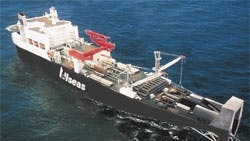Laying large-diameter — up to 60- in. OD — oil and gas-transport pipe on the ocean floor challenges all aspects of motion systems. These challenges require talented engineers, especially when one considers that a ship must lay pipe continuously rather than in short strings. Also, in rough weather, the pipe-laying ship is buffeted by winds, waves, and tides. Yet the ship must avoid buckles in the pipe.
To accomplish these tasks, the Swissbased Allseas Group is building the vessel Solitaire. This dynamically positioned pipe-lay vessel has a number of characteristics that give her advantages over traditional anchored pipe-lay barges. First of all, the Solitaire is ship shaped — rather than barge shaped — and has her own propulsion system. Measuring 935-ft long, she is powered by eight, azimuth rotatable thrusters. Thus she uses neither a rudder nor an anchor to keep her positioned during pipe laying. In turn, she eliminates the need for anchor handling tugs, so she can operate near operating platforms, drilling rigs and other work vessels.
Upon completion in late 1996, the vessel will be capable of sustaining a lay rate of 6 km (3.7 miles) per day.
Three critical, integrated systems are required to meet the challenges of the Solitaire’s operations.
• On-board pipe-assembly plant.
• Three linear pipe tensioners.
• Abandonment and recovery system.
Pipe assembly plant
Commonly called “the firing line,” this onboard capability, designed and built by CRC Evans, Tulsa, Okla., receives 40-ft lengths of pipe, preheats the ends, aligns the sections, welds them, then machines the welds. The Solitaire has a doublejoint facility so it can simultaneously weld two sets of 40-ft sections. The ends of the 80-ft sections are then preheated and welded together in the firing line to form a continuous pipe.
Each weld is examined by X-ray and, if acceptable, is wrapped in a synthetic material at the coating station, located at the aft end of the ship. After coating, the pipeline goes into the water and descends to the seabed in an S-curve as the vessel moves forward.
To deliver the pipeline at the proper angle to the sea and avoid buckling, the pipeline is fed onto an outrigger — called a “stinger” — that guides the pipeline on its route to the seabed.
Tensioners
During the pipe-laying process, the pipeline must be kept under proper tension to prevent buckling, which can occur as the pipeline leaves the stinger or as it touches the seabed. To control this tension, three tensioners clamp and move the pipe while the vessel moves forward. The degree of tension depends on the weight of the pipe and sea depth.
Each of the three, four-track, caterpillar-type tensioners — the world’s largest — are rated at 100 metric tons of constant force. The tensioners were designed and built by WesTech Gear Corp., Lynwood, Calif.
Assembled pipe moves through each tensioner on a set of upper and lower tracks that apply pressure to move or hold the pipe. Three tensioners — in sequence — are required so pipe that has been laid off the stern can be held back while the welding operation continues in the factory within the vessel’s hull.
Abandonment and recovery system
When winds, waves or other factors affect operations, the system terminates pipe assembly and tensioning operations. A cap is placed on the pipe-string end, and is then lowered to the seabed with a heavy steel cable with a marker buoy. When conditions improve, the ship locates and captures the marker buoy, retrieves the cable, and brings the pipe end back through the tensioners. New pipe is assembled and welded to the recovered pipe end and assembly and laying operations resume.
This abandonment and recovery (A & R) System, also supplied by WesTech, coordinates its operations with other major systems, particularly the tensioners, to ensure safe abandonment and recovery of the pipe.
Motion system
The on-board pipe assembly plant drives and control system were supplied by Reliance Electric, Cleveland. The operations require 200 ac gearmotors to move welded pipe sections to and through the tensioners, 30 GP2000 inverters to control the pipe-assembly conveyors, and 15, 50-hp vector controlled drives to control pipe transfer rate to the tensioners.
A Reliance AutoMax Distributed Control System and SIGMA Universal Operator Interface/Process Monitor provide central command of the tensioners, coordination of the tensioners with both the on-board pipe factory and A & R system. According to Reliance’s Thomas C. Renner, projector manager, “In addition to providing system coordination and integration, the system’s fiber optic cables provide signal transfer between control and assembly systems with no signal losses or EMI interference with other electrical systems.”
The AutoMax controllers are remotely located. Many of them, including the central control center, are on the vessel’s bridge where pipe-laying operations are monitored by the navigating crew.
WesTech specified four, 300-hp waterjacketed Reliance ac induction motors for each tensioner. The water-jacketed motors take up less space than air-to-air heat exchangers, a critical consideration aboard ship. Also, 12 Reliance regenerative vector-controlled inverters provide tension control regardless of ship movement. These adjustable-speed drives generate and return power to the ship’s power grid.
The fact that the ac motors and drives match the Solitaire’s power system was not the only reason for choosing an ac system. Not only are the ac motors smaller than comparable dc motors, but the ac drives offer an operating power factor of 96%; dc drives reach 88%, at best. Also, maintenance costs are reduced with ac motors because brush replacement is eliminated.
A combination of eight water-cooled 400-hp Reliance vector controlled drives and motors power a dual-drum A & R winch supplied by Bodewes of Holland.
